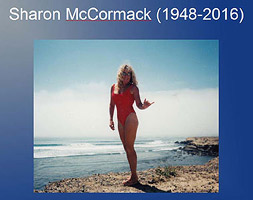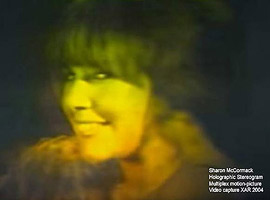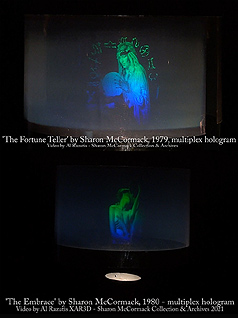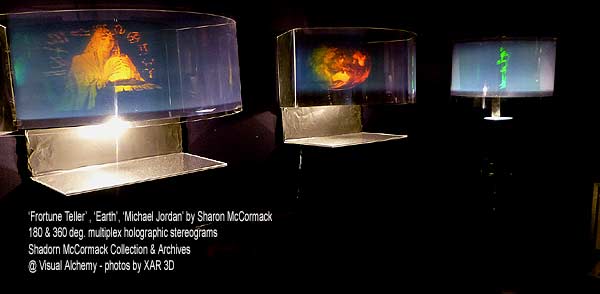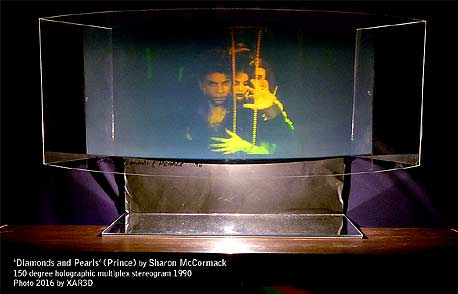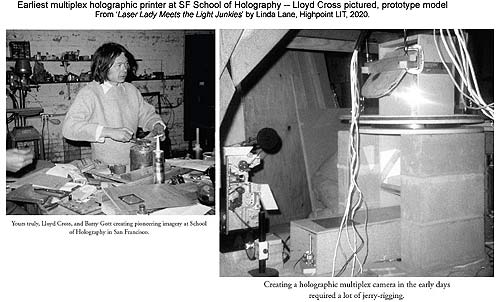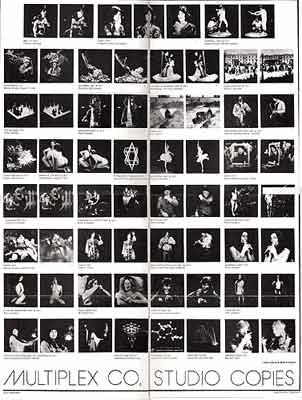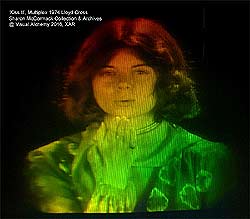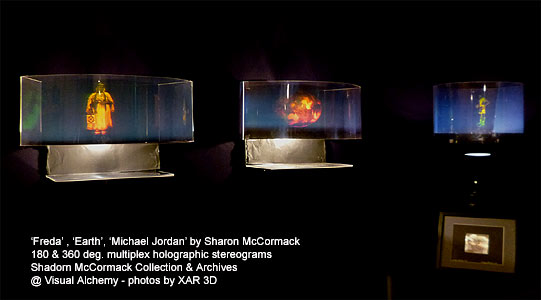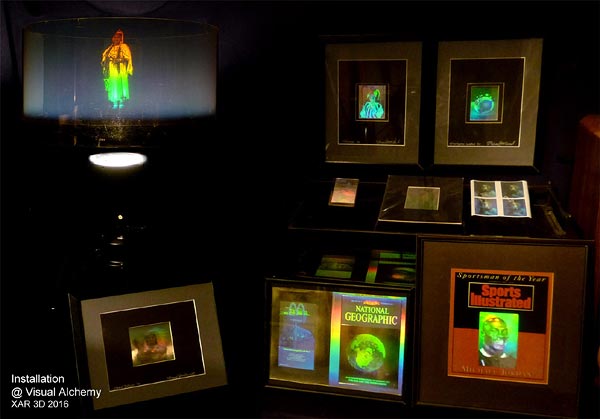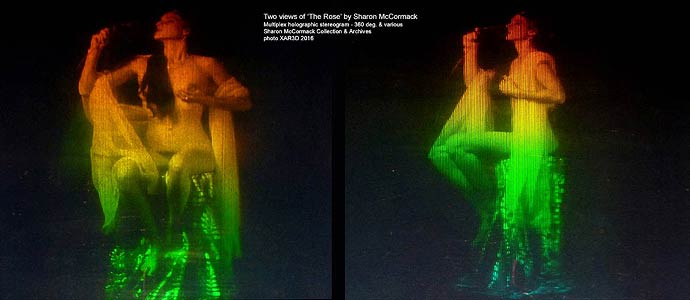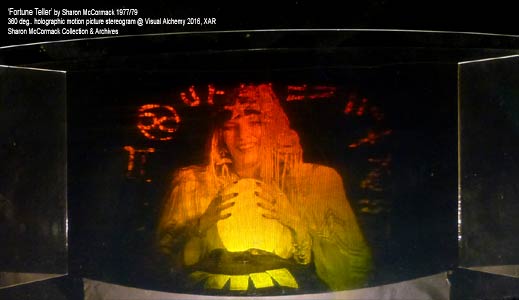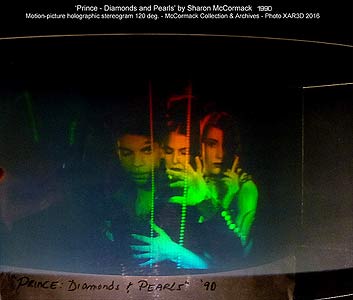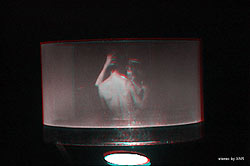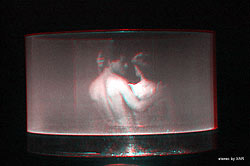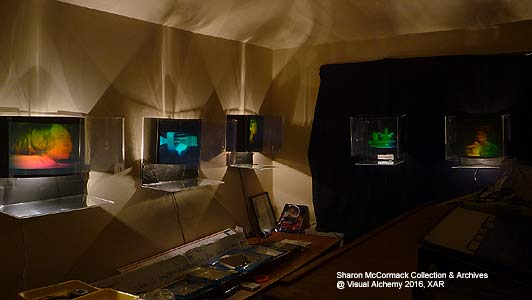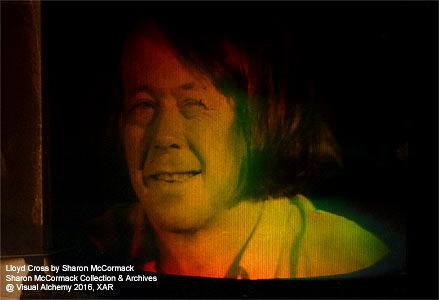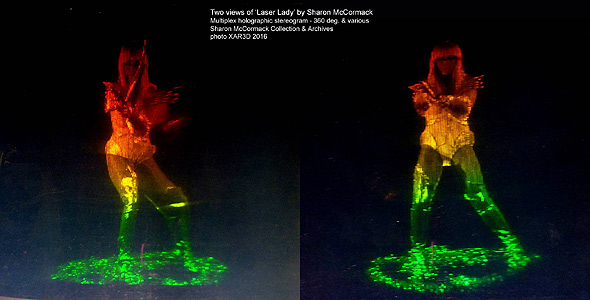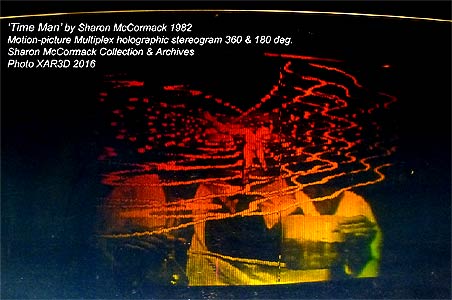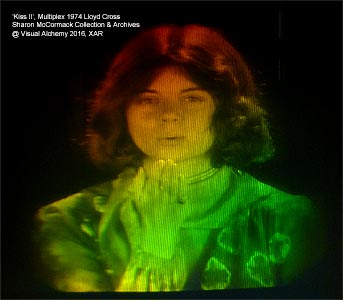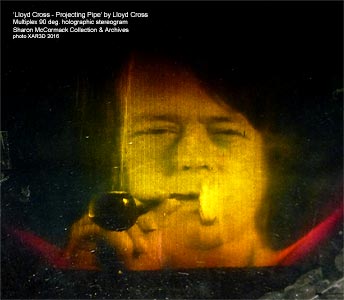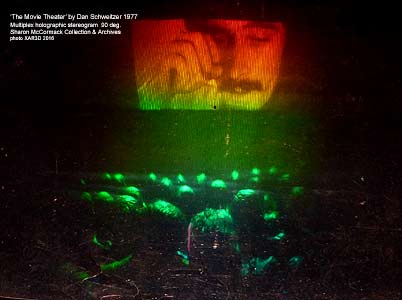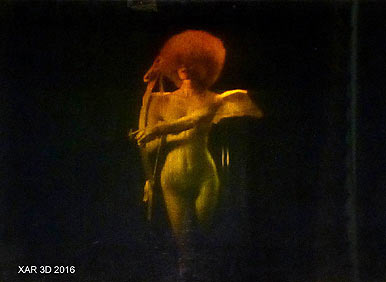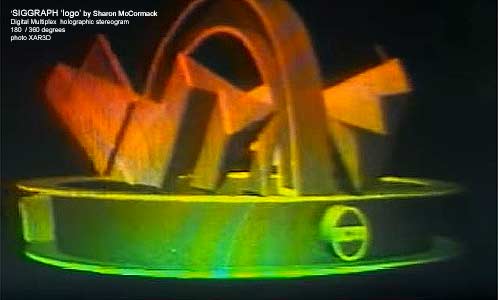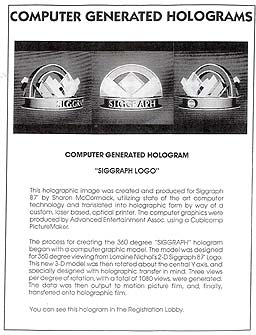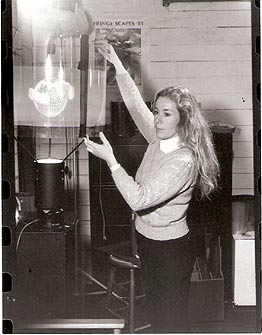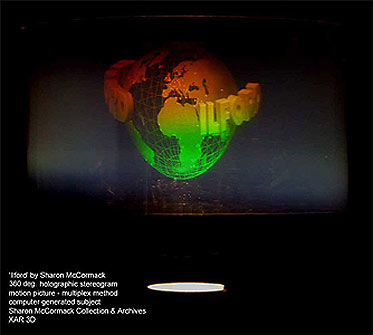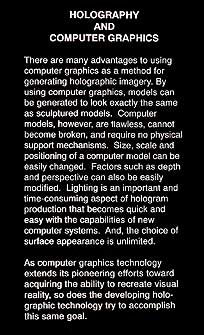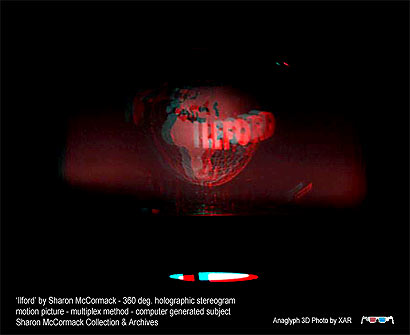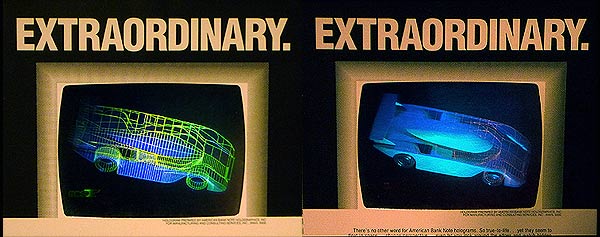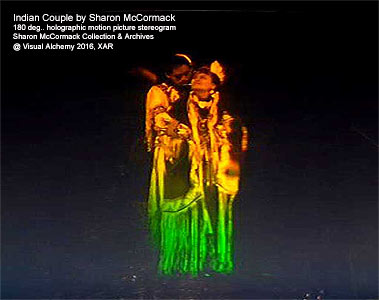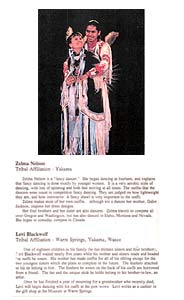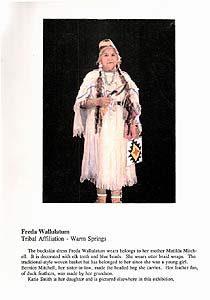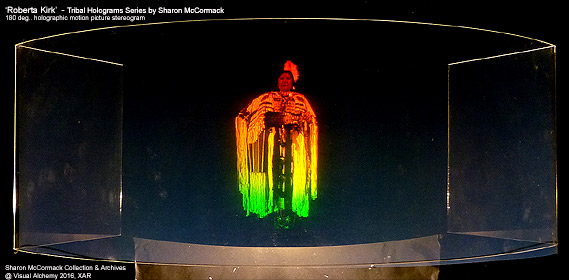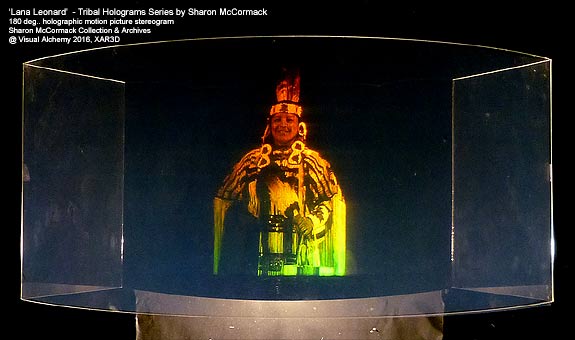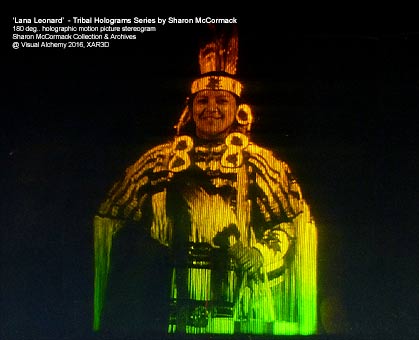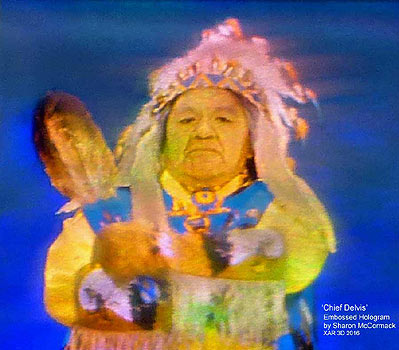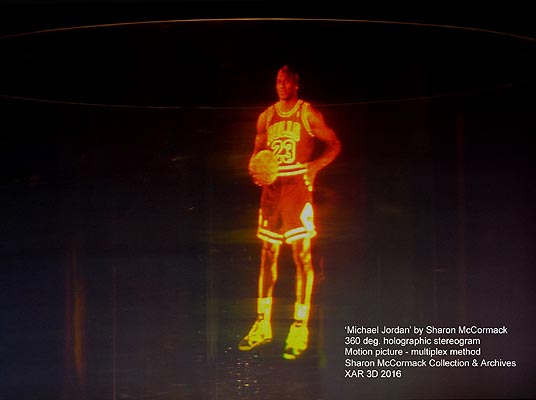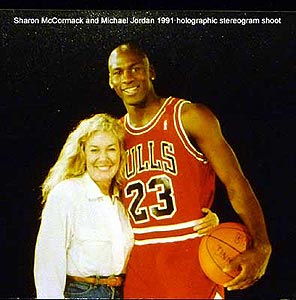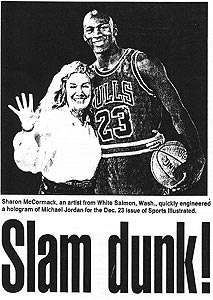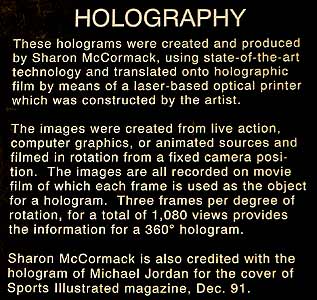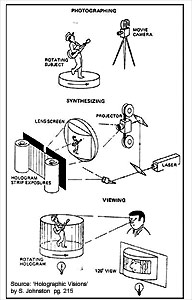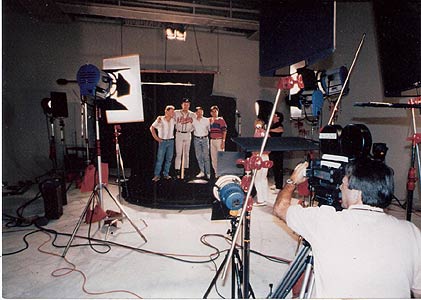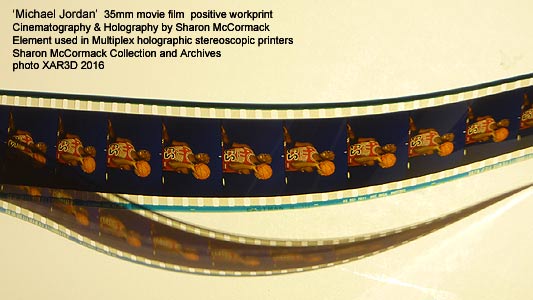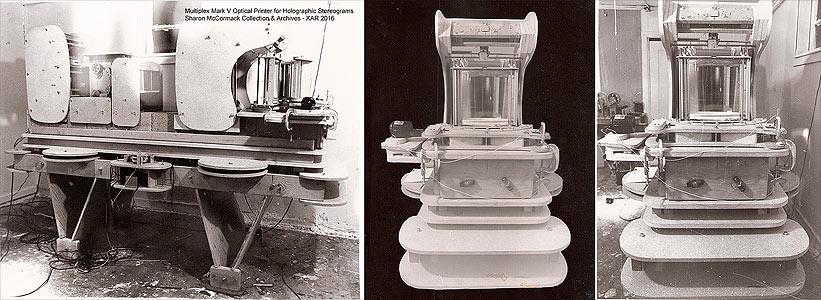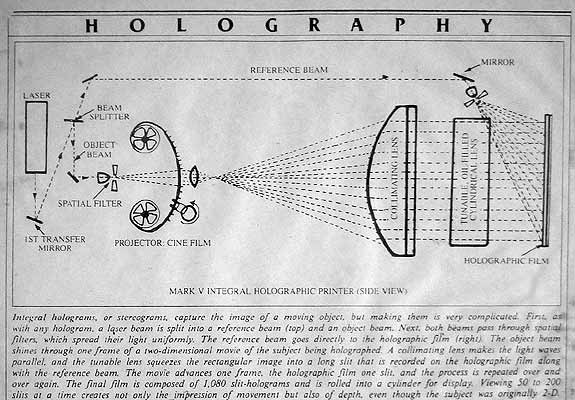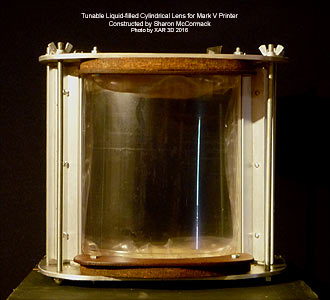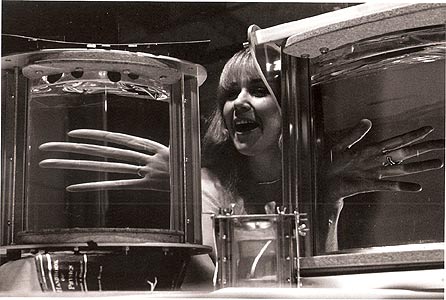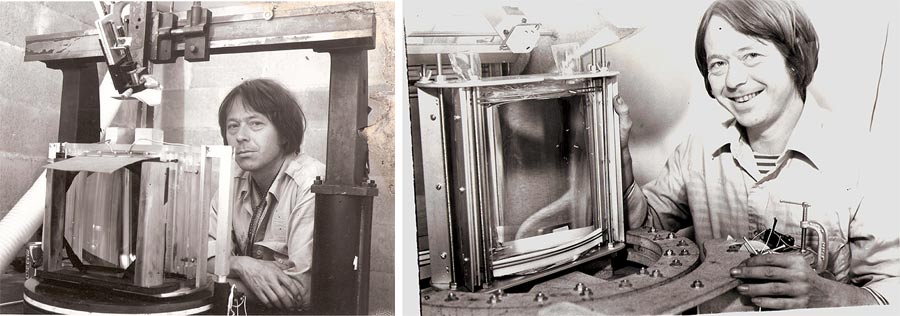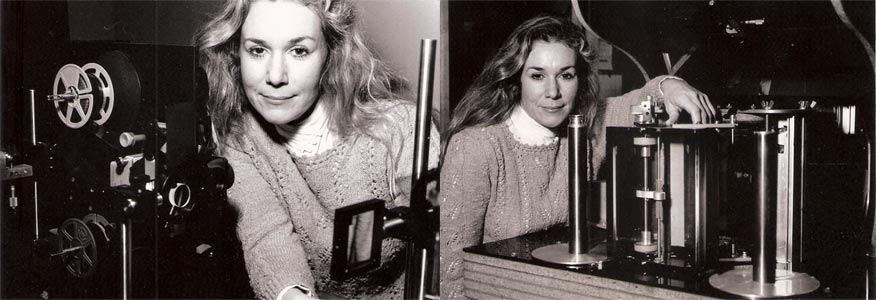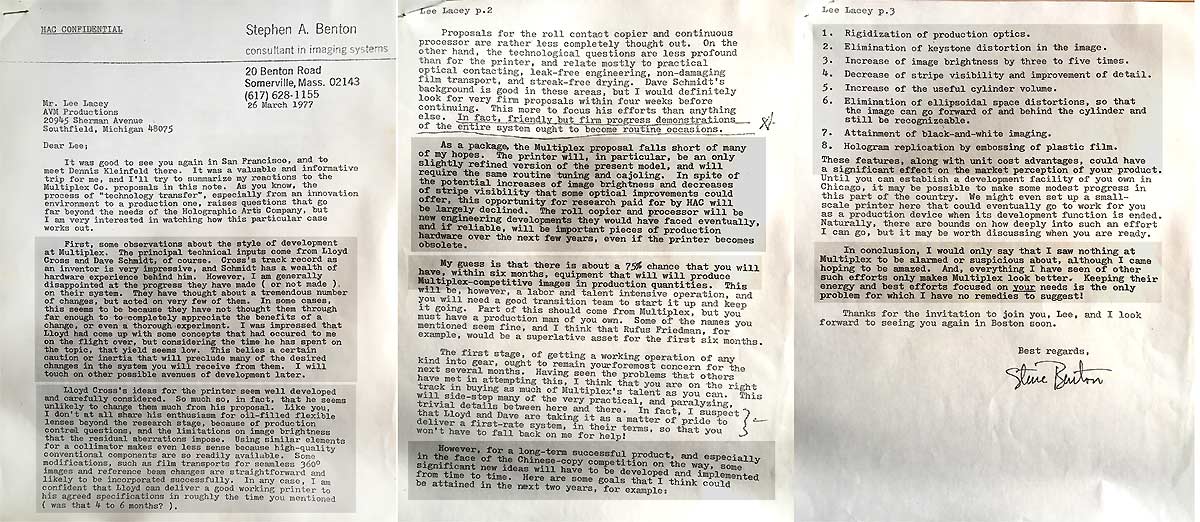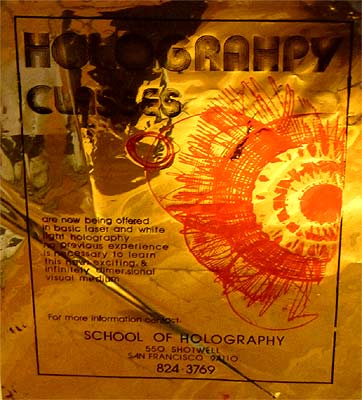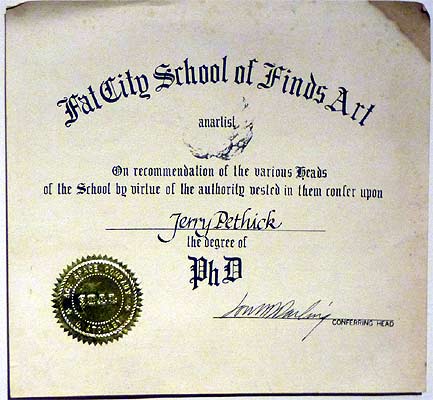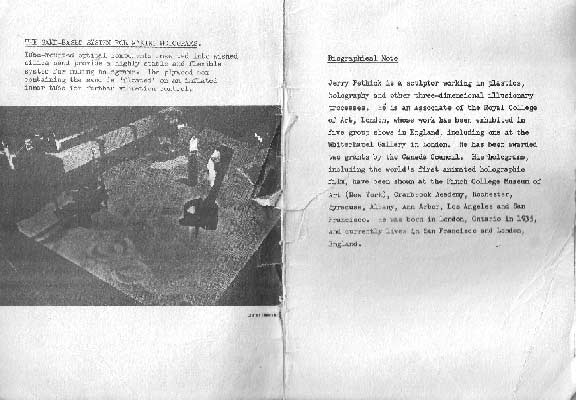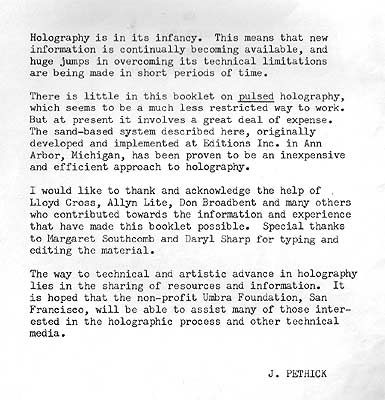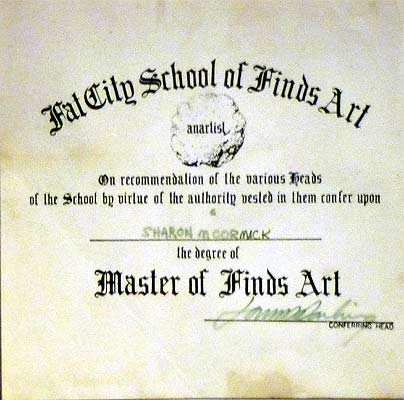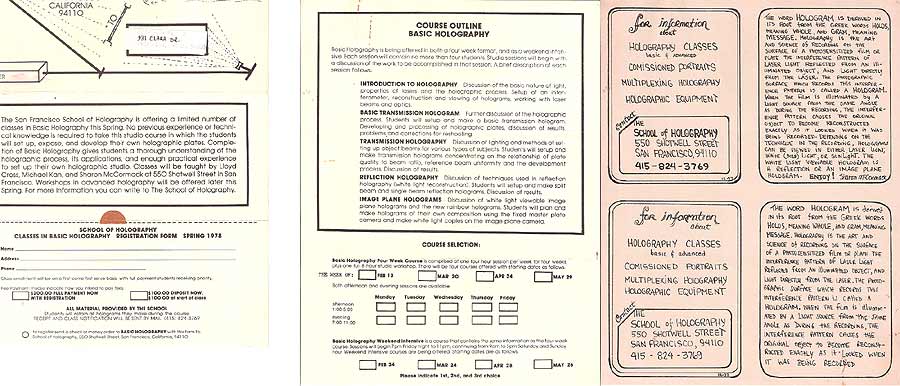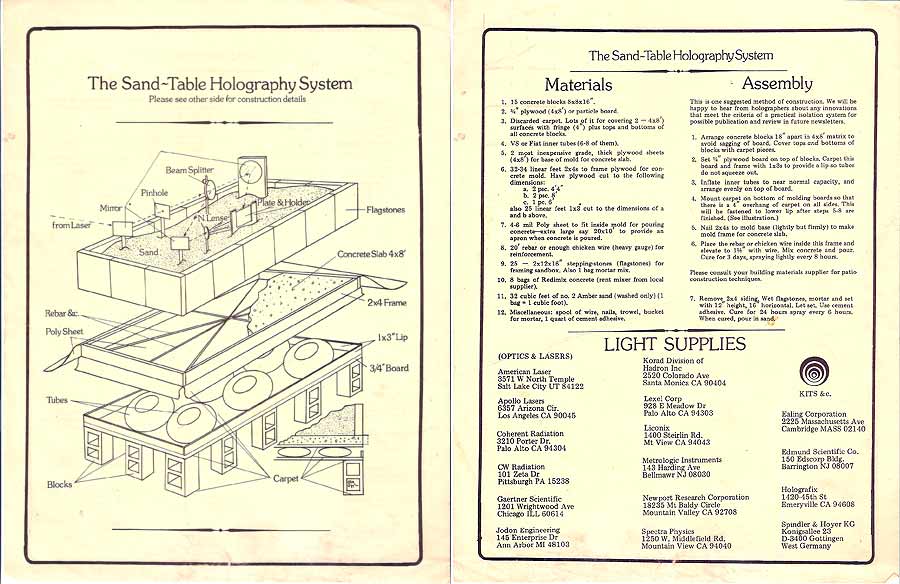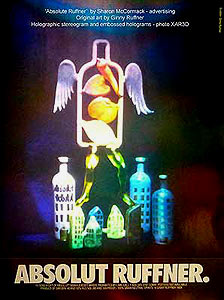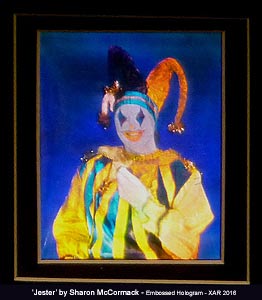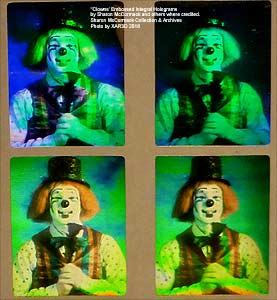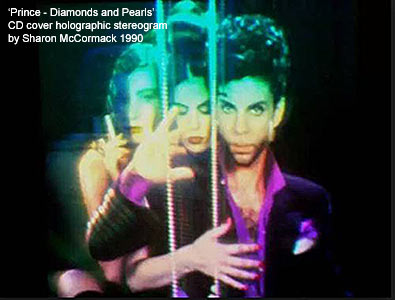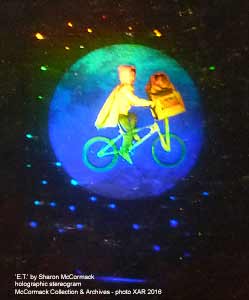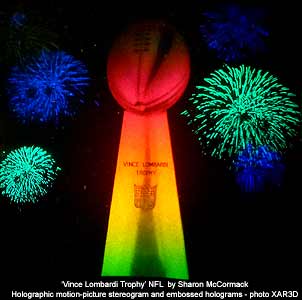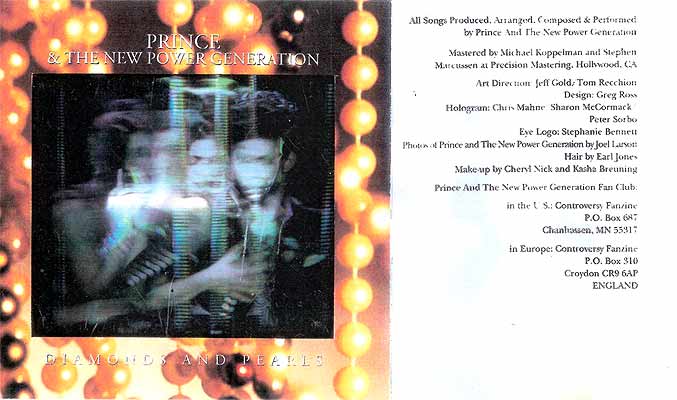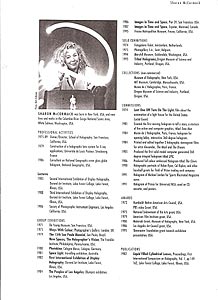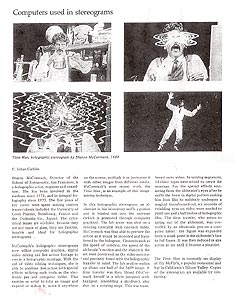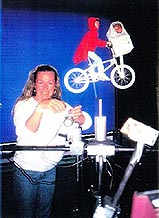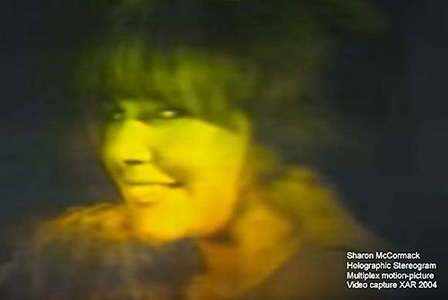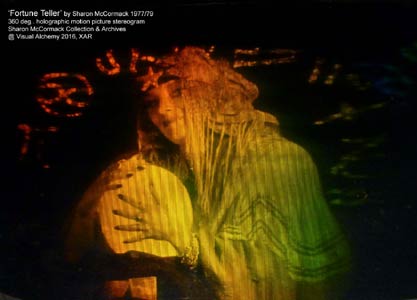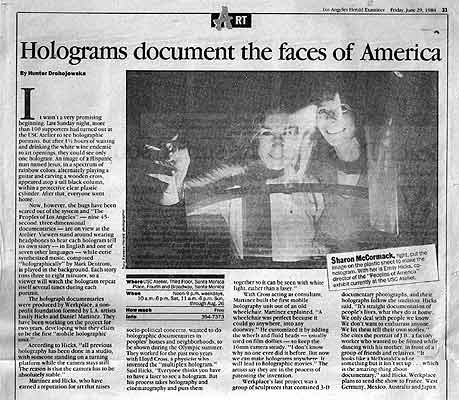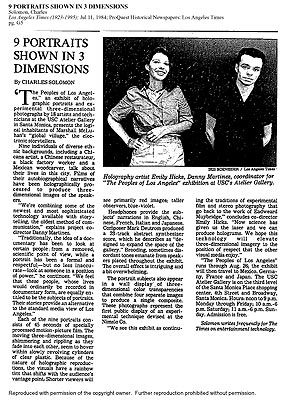Sharon McCormack Collection & Archives
"...my work as an artist who built my technology, prepared costumes and sets, shot in 35mm studio, built holographic printers, and printed this work and the works of many others."
Including History and Arts of >> San Francisco School of Holography,
>> Multiplex Company
and McCormack Holography 1970's - 2000's
HISTORY & PRESENT:
This Collection and Archive was gifted to Al Razutis, by Sharon McCormack in 2016, so he would assume role of administrator, curator, preservationist. This was done shortly before her passing later that year. Razutis has continued since then to preserve and disseminate works from this collection, and to promote the story of these remarkable accomplishments and artists.
This Collection and Archive contents are for sale or lease according to special terms and conditions, and available for lease or rental/exhibition individually or in groups of works. Sale of these items cover the cost of maintaining, preserving, and disseminating this collection.
The works are on display, stored and preserved at Visual Alchemy Studio which is located in British Columbia, Canada. In person visits to this collection are by appointment only, with Al Razutis. Please contact alrazutis&ymail.com by email with your interests.
To lease/exhibit or display selections from this Collection & Archives see Terms and Conditions
2024 Featured holographic works - embossed collectibles

Everything from original motion picture films by McCormack and Cross and the holographic multiplex (integral) movies that were the foundation of embossed holographic works distributed world wide are contained within this collection. This is the real story. This is the real place.
A new sales category and web page -- 'Holographic Collectibles' is now available with unique collectible works catalogued for sale.

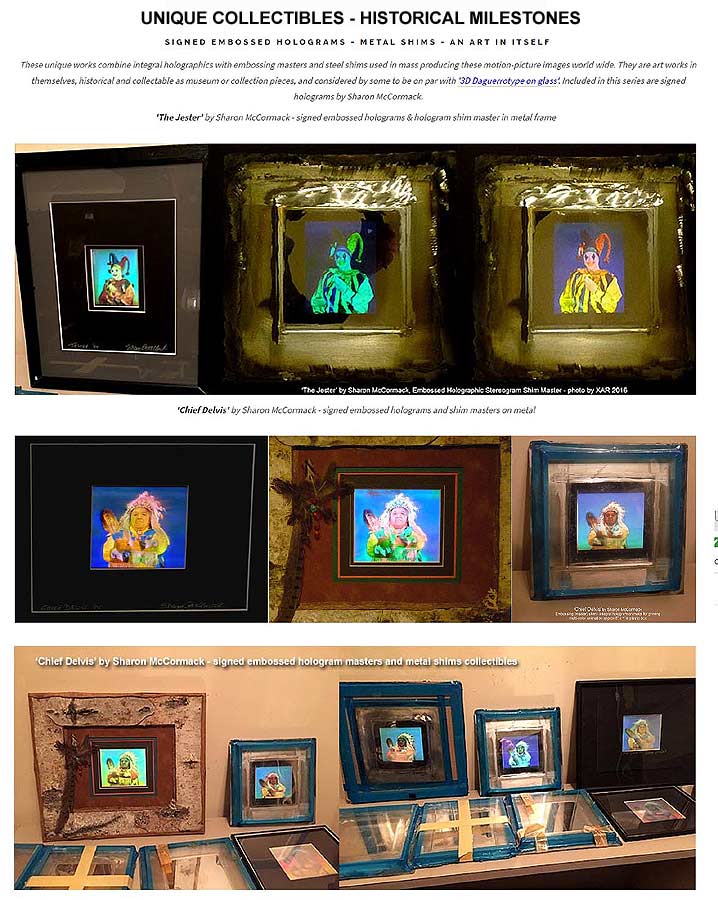
For all collectibles and holographic art purchases on this web site and domain, please contact Al Razutis at alrazutis@ymail.com to discuss your interests.
New re-releases of Sharon McCormack bio videos:
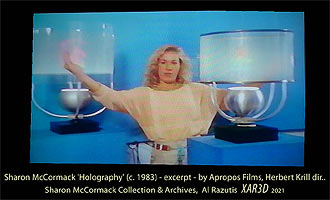

XAR3D Channel:
List of Multiplex integral holograms by Sharon McCormack on You Tube:

>> PLAYLIST for McCormack Archives on YOUTUBE>
'Masterworks' of holography now available for sale or lease
original motion-picture integral (white light multiplex) holograms
by Lloyd Cross and Sharon McCormack
https://www.alchemists.com/visual_alchemy/smca/masterworks-cross-2021.pdf
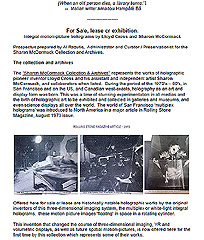

All inquiries for purchase or lease
can be sent to collection and archives administrator Al Razutis, at the e-mail: alrazutis@ymail.com.
Download a pdf information sheet identifying these works to include their original display units: https://www.alchemists.com/visual_alchemy/smca/masterworks-cross-2021.pdf
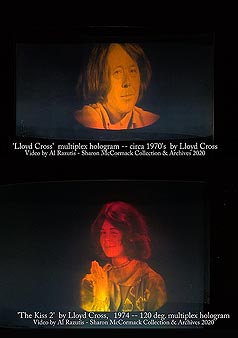
<< Portrait of Lloyd Cross and The Kiss 2 - multiplex holograms - video on YouTube by 'XAR3D 2021'
|
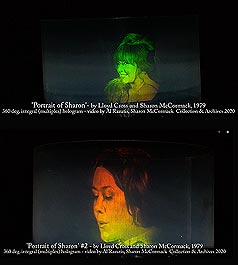
<< Portraits of Sharon McCormack by Lloyd Cross and Sharon McCormack - multiplex holograms - video on YouTube by 'XAR3D 2020'
These original works are of historical significance and set the standards for integral motion-picture holography. They are sold or leased with their original white light and motorized (to rotate) display units and clear cylinders for true display according to their creators' intentions. Please contact Al Razutis at alrazutis@ymail.com to discuss your purchase, exhibition or rental/lease interests. |
A downloadable pdf doc of this 2021 offering is available at https://www.alchemists.com/visual_alchemy/smca/masterworks-cross-2021.pdf

A collage of subjects - motion-picture Multiplex holographic stereograms by Sharon McCormack
180 degree and 360 degree walk-around views and installations:
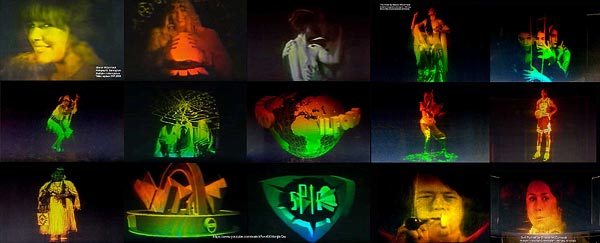
Lloyd Cross collaborations with 'Salvador Dali'
This collection and archives contains famous works by famous arists that were holographically printed by Lloyd Cross, or Sharon McCormack at Multiplex Co. or later McCormack facilities. These multiplex holograms are now documented for the Archives in 2D / 3D photos and film by Al Razutis, curator / admin.
'Holographic Art by Salvador Dali' as printed into holograms by Lloyd Cross
'First Cylindric Chromo-Hologram Portrait of Alice Cooper's Brain' by Dali (Salvador Dali, Selwyn Lissack, Lloyd Cross) 1973

"
... in the winter of 1972 Selwyn Lissack who came here and saw our Multiplex 'Lialiana', the multiplex hologram of Leslie and took it back to New York with him on the basis of a little tiny postage stamp hologram sold Salvador Dali a whole expensive program to make a twelve inch high, twenty four inch diameter 360 degree multiplex of Alice Cooper for one of their promotional campaigns... and in over a perdiod of thirty days with literally a telephone call every day, we finally got the filming done in New York in 16 millimeter film and Selwyn brought it out here (to San Francisco) in 1973, I think around February. And that of course sparked the beginning of the Mark II printer. We now had a customer for one of these holograms."
-- Lloyd Cross, inventor of multiplex (integral) holography
( as cited in pages 9 & 10, 'Story of Multiplex' )
2020 Essays by Al Razutis on the subjects of Dali Holograms and who made them and how:
'Being Dali' -- Who made these holograms? How much are they worth?
'First Cylindric Chromo-Hologram Portrait of Alice Cooper's Brain' by Dali, Lissack, and Lloyd Cross. McCormack Collection & Archives copies of two 'sections' from this classic 1973 hologram.

You Tube clip of 'First Cylindric Chromo-Hologram Portrait of Alice Cooper's Brain' by Dali' (sections only)
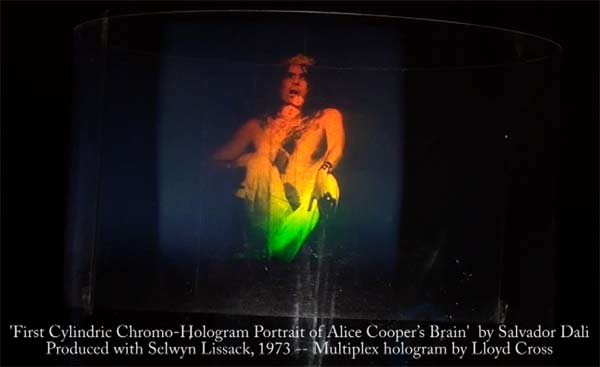
Documented by Al Razutis for Sharon McCormack Collection and Archives
More background and information on 'Alice Cooper's Brain' hologram can be found here in my essay: 'How Much For That Holo?' - Dali Holograms
Web articles:
Pictorial of 'When Alice Cooper Met Salvador Dali in New York, 1973'
'When Salvador Dalí Met Alice Cooper & Turned Him into a Hologram: The Meeting of Two Kings of Camp (1973)'
'Dali Painting Gala' -- Final Dali & Cross Multiplex Hologram
360 degree moving hologram by Dali, as printed by Lloyd Cross, collection copies'Dali Painting Gala' by Salvador Dali (Salvador Dali, Selwyn Lissack, Lloyd Cross) 1976
Multiplex hologram by Lloyd Cross -- SMC&A collection copies - 360 degree integral
View 2 min. video - 'Dali Painting Gala' multiplex hologram on You Tube narrated by A.R. 2020

More background and information on 'Dali Painting Gala' hologram can be found here in Al Razutis essay: 'How Much For That Holo?' - Dali / Gala
-----------------------------
'Prince' by Sharon McCormack
Holographic Stereogram Portait / CD album cover
Rainbow Transmission Multiplex (Integral) & Embossed Versions
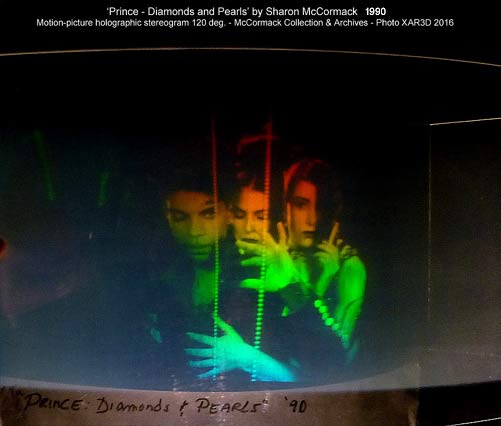
Embossed Hologram CD Covers and Graphics from McCormack integrals

Sharon McCormack describes making the Prince holograms
'Diamonds and Pearls' - CD hologram - Prince / McCormack - 2 min. video YouTube
MULTIPLEX (INTEGRAL) HOLOGRAPHY
The white-light viewable multiplex hologram, also called an 'integral hologram' was invented by Lloyd Cross, a physicist turned artist turned educator in 1971. This form of holography combined motion-picture frame sequences (shot photographically in 2D) with a form of projected (aerial) image holography in the making of spatially 'multiplexed' (thin strips of squeezed images set side by side in a row) transmission holograms, first laser viewable only, later viewable by white light. He demonstrated this invention and concept in a series of stages (and "Mark Series Printers"), first as a crude 40-image animation on a small piece of film, then as more sophisticated and larger displays made by more sophisticated automated printers, including the final displays illuminated by white light as a series of products that were marketed all over the world. His story reveals the beginnings:
"
... with our present technology we could not capture that incredible three dimensional scene with people and horses and so forth on a holographic plate. So, I became quite determined to at that time to do something about it, and of course one of the answers was multiplexing holography... I worked out the ideas to make an integral hologram from cine film at the Verde Valley School (in 1971)."
-- Lloyd Cross, inventor of multiplex (integral) holography
( as cited in pages 6 & 7, 'Story of Multiplex' and original patent unfiled application below )
U.S. Patent Application for original multiplex (integral) hologram printer by Lloyd Cross
-- 1973 draft copy - sample pages
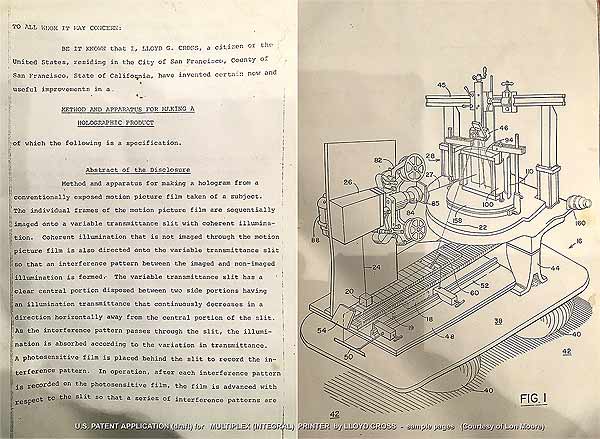
Download PDF copy
Multiplex Holographic Printer Patent Applicaton - by Lloyd Cross
- 21 pages, 1 illustration, document courtesy of Lon Moore
First person historical accounts:
'The Story of Multiplex' & School of Holography by Lloyd Cross (.PDF)
Photo of (l to r) Lloyd Cross, Michael Kan, the principal designer - builders of the multiplex hologram printer & lenses, and Dr. Tung Jeong from Wake Forest College Physics Dept, a visitor to the School of Holography - Multiplex Shotwell Street San Francisco building , circa 1974 photo. Source: Sharon McCormack Collection & Archives.
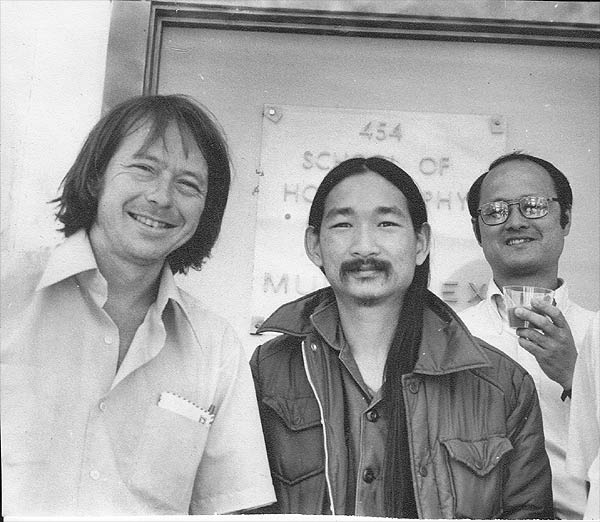
John Fairstein's recollections of The San Francisco School of Holography and working with multiplex printers (this page below)
NOTE: the terms 'multiplex hologram', 'integral hologram' and 'holographic stereogram', are used interchangeably here., as they appear to be used interchangeably in the 1970's.
It is clear from the documentation provided here that Lloyd Cross 'invented WLT multiplex holography' not from scratch but as a invention that acknowledged 'prior art' and featured notable improvements on what had existed before. It is also abundantly clear that Dr. Steve Benton invented white-light transmission (rainbow) holography. Together these two techniques were combined by Cross to invent the multiplex hologram aka integral hologram aka holo stereogram.
Expert technical descriptions of multiplex holography, history and subsequent improvements:
Method and System for Constructing a Composite Hologram by K. Haines, Eidetic Images, US Patent, 1982 (.PDF)
Multiplex holography: some new methods by E.N. Leith & P. Voulgaris, SPIE 1985 (.PDF)
Holographic Optical Elements
for Holographic Stereogram Printers by M. Klug, MIT 1989 (.PDF)
Optics for Full-parallax Holographic Stereograms by Michael A. Klug, SPIE 1997 (.PDF)
The Generalized Holographic Stereogram
by Michael W. Halle, MIT 1988 (.PDF)
A quick introduction with photos from the collection:
|
Sample hologram projection unit - display unit for McCormack Multiplex holographic stereograms ('integrals')- 360 degree motorized cylinder & walk-around view. The 3D image with horizontal parallax only 'floats' in the center of a moving cyliner which is illuminated by a white light bulb. The 3D images move in various actions and in slow motion.
The 'holographic stereogram' (or 'integral') combines 2D cinematography showing horizontal parallax and motion with 'holographic printing' (using Lloyd Cross' invented 'printers' - Mark I to Mark V - as improved on by Michael Kan, Sharon McCormack and Lloyd Cross lenses). This was a remarkable development in holography with a world-wide impact.Viewers could 'walk around' a movie playing in 360 degrees with an image appearing to float in a cylinder. It suggested 'holographic TV' or 'holographic movies' and were exhibited in the 1970's and continuing through the 1990's, 2000's. |
Multiplex Collection -- History, Background & Views
A short recitation for the record:
When physicist turned holographer and new artist Lloyd Cross teamed up with artist Jerry Pethick to create the San Francisco School of Holography in 1971 he also set the stage to further invent, develop into products, and educate, and distribute world-wide a new form of holographic motion-pictures, 'the Multiplex Hologram', also called 'integral hologram' or the 'holographic stereogram'.
N.B.: What's interesting is that these two partners Cross and Pethick had worked to create the first 'holographic art exhibitions' to happen in North America in the late 1960's. This story is told HERE

Photo of Jerry Pethick (left) and Lloyd Cross (right) - circa 1970 - collection of Margaret Pethick.
What the inventor of holography Dr. Dennis Gabor thought when seeing a multiplex hologram for the first time at the 1973 Medical Applications Show in NYC:
|
"Dennis Gabor was touring the exhibits, followed everywhere by a large group of acolytes. When he came to the Multiplex he stopped and peered into it (the display was motorized). After a long pause while we held our breath, he said.......... "Marvelous". " -- recollection by Lon Moore, 2021 |
How it all began
Cross had envisioned a way to 'make holographic movies' in Verde Valley, New Mexico while working on projects, but it was when he co-founded the San Francisco School of Holography with Jerry Pethick, a Canadian transplant and pioneer holographic artist, that the idea of creating these 'multiplex' holograms, also called 'integrals' by Cross and others would take off and include many collaborative efforts.
|
A most fortuitous chance meeting between two greats in holography Lloyd Cross recounts in his memoirs the first public showing of multiplex holograms at a medical conference on holography: "This was one of the first public showings of the multiplex holograms attended by Emmett Leith and Dennis Gabor. Both of those gentlemen saw the hologram for the first time and, of course, it was by far the most spectacular things at the conference. One interesting at the conference tough, sat the table right next to mine where I had the 360 set-up was a little white light rainbow hologram of Steve Benton. And there was Steve Benton looking at my hologram and me looking at his hologram and both of us realising that putting those two together was the way to make a white light viewable multiplex (my underline) although the way wasn't clear yet. ( ... ) "I immediately began to work on the white light technique. I made a rainbow hologram of a trian which developed into the rainbow camera technique that we set up into production later on in the fall of 1972 and then about July or August I made the first whie light hologram of Liliana holding a tea cup. To do this of course I had to make the plastic oil filled lens. I knew technically what I was going to get and I told everybody for a couple of weeks ahead of time what was going to happen what it was going to look like. It was going to be very coarse lines very bright light viewable totally clear perhaps with some weird optical effects as well. But, again, I didn't know what the visual impact was going to be until I saw the hologram dna all I can say about it is for the first four hours after the hologram came out of the wash there is no-one in this building that did anything except look at that hologram, well into the night. It was incredible." -- Pages 10, 11 Story of Multiplex .pdf document Lon Moore recounts these events also: "Lloyd and I both saw Benton’s hologram for the first time in 1973 in NYC at the Medical Applications of Holography Conference (organized by Pal Greguss)/ It was where we presented a Multiplex for the first time and caused quite a stir. We only had the laser illuminated version, but people couldn’t take their eyes off it. I had done a filming in S.F. of a Belly Dancer, and there she was spinning around (with plenty of 'time smear') with a crowd of mostly scientists gawking . In fact we had unintentionally stolen the thunder of Steve Benton who was presenting his Rainbow Hologram (of a train) just several yards away. That is where we saw Benton’s Rainbow for the first time, and he got his first look at a Multiplex. Subsequently, talking to both Lloyd and Steve (separately), they had both realized right then that the next step in Multiplex would be applying Benton’s technique." --- Lon Moore, 2021 email |
Who made the first white-light viewable multiplex (integral) holograms and, where when and why?
'What Lloyd Cross, inventor of multiplex / integral holography said of this process':
"
... in the winter of 1972 Selwyn Lissack who came here and saw our Multiplex 'Liliana', the multiplex hologram of Leslie and took it back to New York with him on the basis of a little tiny postage stamp hologram sold Salvador Dali a whole expensive program to make a twelve inch high, twenty four inch diameter 360 degree multiplex of Alice Cooper for one of their promotional campaigns... and in over a perdiod of thirty days with literally a telephone call every day, we finally got the filming done in New York in 16 millimeter film and Selwyn brought it out here (to San Francisco) in 1973, I think around February. And that of course sparked the beginning of the Mark II printer. We now had a customer for one of these holograms."
-- Lloyd Cross, inventor of multiplex (integral) holography
( as cited in pages 9 & 10, 'Story of Multiplex' )
Directly from this San Francisco School of Holography and later the Multiplex Company group efforts came the versions of the 'multiplex hologram' and the 'multiplex hologram printer' necessary for converting motion-picture film strips into motion-picture holograms by way of this unique aerial image printing process. Soon versions of this printer used tunable oil-filled lenses to improve image quality, the cylindrical lenses first suggested by an assistant Michael Kan. These printers were constructed as partially collaborative efforts at the SF School of Holography (SOH) to include the first students Lon Moore, Gary Adams, Fred Unterseher, and assistants Michael Kan, Rufus Friedman, Dave Schmidt, and later Sharon McCormack who worked to keep this medium and school of holography alive for some years after the original school closed . Some of these first students (Moore, Unterseher) became teachers themselves, and went on to successful independent careers of their own in holography. More pictures and details of multiplex printers are in the section on technology
Multiplex with subject on turntable - with Lloyd Cross on camera and laser multiplex holograms on film
State of the Art: Holography -- Rolling Stone Magazine -- August, 1973


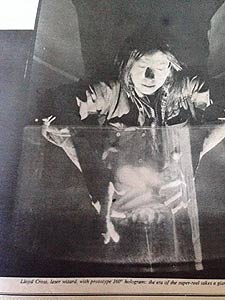
The multiplex hologram was featured on screen in films such as 'Logan's Run' (1977) and 'The Man Who Fell To Earth'(1978), while holography was simulated by VFX fakery in 'Star Wars' also in the late 1970's.
The place of this story in the Sharon McCormack Collection and Archives is confirmed by the close relationship Cross had with Sharon McCormack after her arrival to the School of Holography and Multiplex in the mid 1970's. Together they created some notable holograms, created lenses and printers to improve on Cross' original invention.
A view of Multiplex Co. in 1975 and sample 1974 partner agreement of Lloyd Cross and Dave Schmidt (courtesy Lon Moore)
The original partners in Multiplex Co. included Dave Schmidt and Peter Claudius, who were called the 'pornographers'
by others, all of which adds to the 'drama of things' in these formative years.
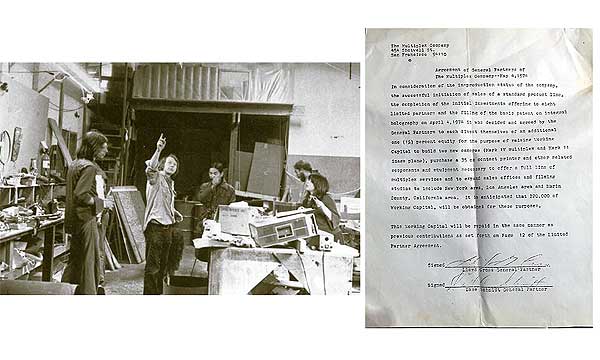
RESOURCES:
'The Story of Multiplex' & School of Holography by Lloyd Cross (.PDF)
John Fairstein's The San Francisco School of Holography (web site with pages)
Lloyd Cross - Bio / Achievements up to 1970 (.PDF)
Jerry Pethick - Bio / Achievements up to 1970 (.PDF)
HISTORY: 1970'S Multiplex Company Catalog - Distribution Flyer
Multiplex Company Catalog - Distribution Flyer late 1970's (.PDF downloadable file)
Visit: Multiplex Apparatus Technology & Printers
Milestone multiplex holograms on video:
Portrait of Lloyd Cross and The Kiss 2 - multiplex holograms - video by 'XAR3D 2020'
These two works, a 180 degree self-portrait of and by Lloyd Cross and the famous 'Kiss 2' multiplex hologram by Cross (also called 'integrals') which placed this 70's art and display form on the map and into commercial success world wide, for decades adorning magazine covers (National Geographic, Sports Illustrated) are documented in HD 3D and 2D by XAR3D (Al Razutis) as part of the Sharon McCormack Collection and archives for 'posterity'.
These multiplex holograms were authored by the inventor of the multiplex (integral) motion picture hologram Lloyd Cross are classics in the history of hybrid (with motion-pictures) forms of holography. This invention with white-light illumination made motion-picture holography accessible to word-wide audiences and clients, and as you read in the section on Salvador Dali multiplex holograms the original 'Kiss' multiplex hologram by Cross is what sold Selwyn Lissack to sell Dali on them and make works of art using this very process.
Enlarge Thumbnail of Cross & Kiss 2 in separate window
A living source with first-hand experience and information on Lloyd Cross, San Francisco School of Holography and multiplex holograms is Linda Lane, whose very entertaining book 'Laser Lady Meets the Light Junkies - a Hollywood Memoir contains rare details and insights into how these inventions occurred.

Excerpts from the Linda Lane book 'Laser Lady Meets the Light Junkies' on the making of Dali Alice Cooper hologram
- click to enlarge collage in separate window:
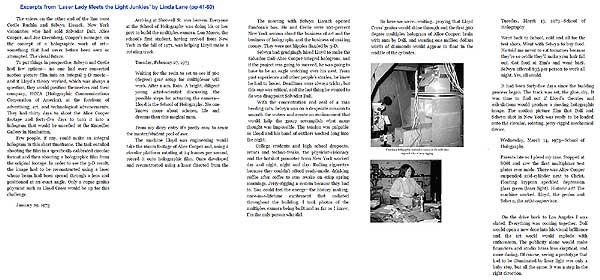
Another source of first-hand information on 1970's multiplex holograms and SF School of Holography is John Fairstein who wrote the following ( see: John Fairstein's The San Francisco School of Holography ) as excerpted here for the record.
|
'The San Francisco School of Holography' --- ©1997, 2005, 2018 John Fairstein (Excerpted text) Multiplex Holography "Sometime in late 1973 or early 1974, Lloyd (Cross) and the SOH (School of Holography) group began constructing a system to multiplex many 2D images into a 3D image. (This idea was first suggested by DeBitteto back in the 1960s). The first incarnation of this system, the Mark I, was built on the floor just beyond the workshop. I only remember it as a squat Rube Goldberg-like contraption. I believe it used some large glass lenses as part of the projection optical train. Lloyd, Gary Adams, Michael Kan, and Lon Moore fussed over it for some time. Ultimately they produced a cylindrical transmission type hologram from a series of motion picture frames. Dr. Tung Jeong, a prominent holographer from Lake Forest College visited about this time and revealed his plans for a similar device which used Fresnel lenses as the projection optics. By this time, though, Lloyd and the crew were beyond paper plans -- they were actually producing holograms. "Also about this same time, Steve Benton at Polaroid invented a new method called 'rainbow' holography which allowed holograms to be reconstructed in white light. The trick was to eliminate vertical parallax, but retain horizontal parallax. When reconstructed with white light, the image smeared into a rainbow up and down, but was fully 3D in the horizontal plane. So long as your eyes remained horizontal the effect was stunning. What a revolution! (...two sentences omitted -- see Lloyd Cross and Lon Moore recollections of the chance meeting between Cross and Steve Benton regarding their inventions and how it resulted in the white-light multiplex hologram) "Lloyd pondered the rainbow hologram for a few days, then promptly produced an example in a sandbox. The trick was to produce a master hologram of the subject, then create a secondary focused image hologram by reconstructing only a tiny horizontal section of the master hologram. At first the reconstructing beam was masked down to a thin stripe with an aperture. Unfortunately, the process of masking the beam wasted a lot of light. Later Michael Kan devised a clever method of producing a thin horizontal beam using two convex lenses. He canted the first lens at about 30 degrees, and by manipulating the distance between the lenses, produced a bright, thin horizontal beam with no light wasted. The Multiplex 'Camera' "Armed with the new rainbow technique and new ideas on liquid lenses, tension structures, slit optics, etc., Lloyd and the SOH crew set out to build the Mark II multiplexing camera. The Mark II was constructed of particle board sub-assemblies held together with threaded rod clamps in a "tension structure" and floated on small airplane tire inner tubes.MK III multiplex camera "The subject of the hologram was filmed with a 35mm motion picture camera while being rotated on a turntable. Each frame of film corresponded to 1/3 degree of rotation. I believe they used Eastman Double-XX film. "The 35mm motion picture film positive print was then loaded into a particle board projector at one end of the Mark II multiplex camera. The projector used a unique pull-down mechanism to gently advance each frame and hold it in place for projection onto the holographic film. Liquid Lenses "Lloyd planned to generate a 'rainbow' hologram in one step by projecting the film frame through a large aperture collimator, and then compressing the image horizontally with a second large aperture cylindrical lens. To achieve the large aperture required using "thick" lenses with a clear aperture of over 9 1/2 inches (the width of the holographic film). The cost of grinding glass lenses to these specifications would be enormous, so Lloyd proposed fabricating a pair of liquid filled cylindrical lenses. The axes of the lenses would be orthgonal-- collimation would be performed by both lenses, and the horizontal compression would be performed by the second lens. I believe the focal point was actually slightly in front of the film.Liquid lens "Back in the early 1970s, desk top computers were not common, so Lloyd used a pocket calculator to compute the required lens curvature. Though I don't understand the math, apparently it required a long series of iterative steps requiring several days of tedious calculation. I remember him seated in an old chair punching in numbers. "The lenses were fabricated by bending optical grade plexiglass to the desired curvature to form a hollow chamber. The chamber was then filled with high grade mineral oil. Adjustments on the top and bottom of the frame holding the plexiglass were provided to 'tune' the lenses and remove sag. Considerable effort was expended in coming up with a sealing mechanism to prevent the mineral oil from leaking. I believe Dave Schmidt made significant contributions to the seals. "Tuning the lenses required considerable skill as I later learned first hand. To the eye, the lens might appear fine, but invisible phase changes played havoc on the laser image. Each "warp" had to be carefully tuned out with tiny adjustments to the lens curvature. Between adjustments, the lens required a "settling" time to come to equilibrium. "The 9-inch high holographic film was placed in a cylindrical film platen made of plexiglass on an indexing table. The film extended over a 120 degree semi-cylinder. The indexing table, also made of particle board, used a door spring as the ring gear. Lloyd shimmed it along its length to exactly adjust the travel. An off the shelf worm gear drove the door spring gear. The entire mechanism from projector to film platen was controlled by a system of solenoids and motors controlled by a bank of rotating particle board cams with switches. To adjust timing required changing the speed of the DC motor with the rheostat and/or adjusting the duration of the cam. "The reference beam, compressed into a slit with Mike Kan's clever optics, was brought in from overhead, making it necessary to record the image upside down to get a hologram which reconstructed from below. The 'Kiss' "The first major effort was the famous 'Kiss'. This fabulous image depicted Pam Brazier blowing a kiss as you walked around the hologram. In short order the SOH produced a number of different multiplex holograms and attempted to create a business. But that's another story..." |
'Expanded Cinema' and Multiplex Holography - Holographic Cinema 1970's
Sample hologram projection unit - display unit for McCormack Multiplex holographic stereograms ('integrals')- 360 degree motorized cylinder & walk-around view. The 3D image with horizontal parallax only 'floats' in the center of a moving cyliner which is illuminated by a white light bulb. The 3D images move in various actions and in slow motion.

The 'holographic stereogram' (or 'integral') combines 2D cinematography showing horizontal parallax and motion with 'holographic printing' (using Lloyd Cross' invented 'printers' - Mark I to Mark V - as improved on by Michael Kan, Sharon McCormack and Lloyd Cross lenses). This was a remarkable development in holography with a world-wide impact.Viewers could 'walk around' a movie playing in 360 degrees with an image appearing to float in a cylinder. It suggested 'holographic TV' or 'holographic movies' and were exhibited in the 1970's and continuing through the 1990's, 2000's.

On display @ Visual Alchemy
Creations by Sharon McCormack -- multiplex motion-picture holographic stereograms and embossed holographic works in various mass mediums - collaborations indicated.
A perennial favorite
'THE FORTUNE TELLER' - 180 degree holograms by Sharon McCormack on YOU TUBE video -- 2020 Narrated by A. Razutis


>>
'The Fortune Teller' 1 min. video clip on YouTube - in HD
This is the 'largest and most complete exhibition - collection - archives of Multiplex holography' currently in existence in (all of) Canada and the US West-Coast. It is available for special exhibition, tours, installation. See McCormack Collection & Archives Terms for more information.
These Works can be rented/leased individually or in curated groups
A Room with Prince 'Diamonds and Pearls' Multiplex motion-picture stereogram and embossed Holograms by Sharon McCormack - Collection

Sharon McCormack describes making the Prince holograms
'Diamonds and Pearls' - CD hologram - Prince / McCormack - 2 min. video
VIDEOS in 3D and 2D of Holograms @ Visual Alchemy (West-Coast Artists in Light - Volume 4)

More Embossed Holograms by McCormack
Sports celebrities by Sharon McCormack 1990's
Michael Jordan 1991 and Rickey Henderson 1993
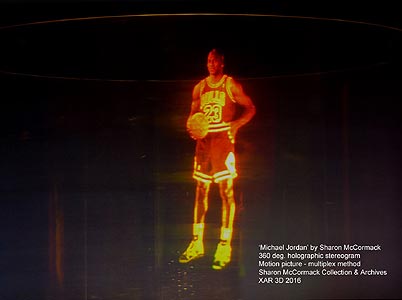
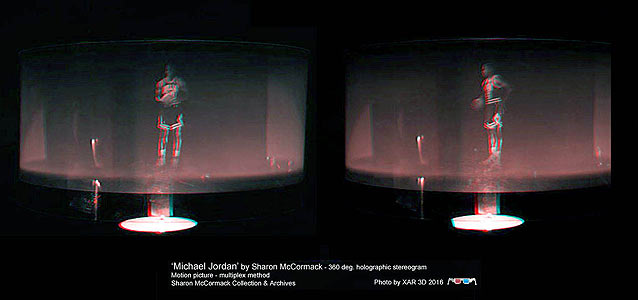
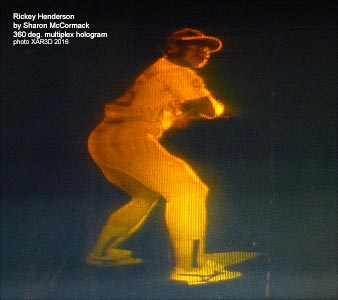
A curator's favorite:
'The Embrace' by Sharon McCormack
360 deg. Multiplex motion-picture Holographic Stereogram
""I've always loved sensuality in photography... so I created The Embrace, sensuality in 3D." -- Sharon McCormack
The Embrace 3 min. 2021 video clip on YouTube - in 2D & 3D
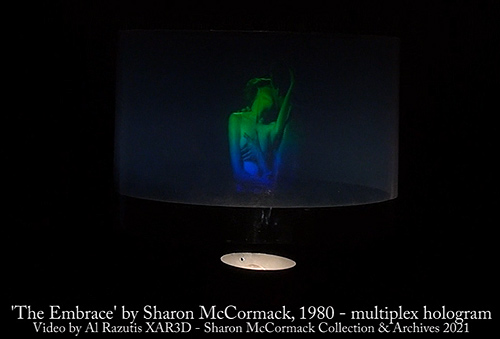
Three
views in time, in anaglyph 3D  ,
of multiplex holographic stereogram - hologram "The Embrace" by Sharon McCormack
- Stereo 3D photos by Al Razutis
,
of multiplex holographic stereogram - hologram "The Embrace" by Sharon McCormack
- Stereo 3D photos by Al Razutis
|
3D VIEWING NOTE: 3D Holograms are depicted in web-friendly 2D
and anaglyph (red/cyan) 3D |
VIDEOS on YOU TUBE - 3D and 2D of Holograms @ Visual Alchemy

The Curator's Room - Research - All Topics - All Authors
Multiplex motion-picture holograms by Sharon McCormack and Lloyd Cross inlcuding early computer-generated holograms by McCormack

Portrait of Lloyd Cross and The Kiss 2 - multiplex holograms - video by 'XAR3D 2020'
These two works, a 180 degree self-portrait of and by Lloyd Cross and the famous 'Kiss 2' multiplex hologram by Cross (also called 'integrals') which placed this 70's art and display form on the map and into commercial success world wide, for decades adorning magazine covers (National Geographic, Sports Illustrated) are documented in HD 3D and 2D by XAR3D (Al Razutis) as part of the Sharon McCormack Collection and archives for 'posterity'.
These multiplex holograms were authored by the inventor of the multiplex (integral) motion picture hologram Lloyd Cross and as such are classics. This invention allowed for white-light illumination making it accessible to word-wide audiences and clients.
Enlarge Thumbnail of Cross & Kiss 2 in separate window
---------------------------

Portraits of Sharon McCormack by Lloyd Cross and Sharon McCormack - multiplex holograms - video by 'XAR3D 2020'
These two portraits by Cross are 360 degree 'walk around' cylindrical holograms mounted on their original Multiplex housings which rotated the hologram in a slow speed, all of which is reproduced here on HD video by AR, in 2D and 3D for the Sharon McCormack Collection. The first 'Portrait of Sharon' ('Sharon with boa') was exhibited at Franklin Institute's 1979 "New Spaces - A Holographer's Vision" exhibition of holographic art. The second "Portrait of Sharon" features Sharon McCormack with a (Star Wars) "Princess Leia" hair style, also 360 degree, also attributed to Lloyd Cross (and Sharon McCormack) and because of the character referenced it would also appear to have been made in or around 1979, or at least after 1977 when Star Wars (the movie) was released.
Enlarge Thumbnail of Portraits of Sharon in separate window
Including early works, later finds, and works by other holographic artists
VIDEOS on YOU TUBE - 3D and 2D of Holograms @ Visual Alchemy

Sharon McCormack Computer Graphics - Holographics
PDF Sheets on Computer Graphics
SPIE 1986 Paper by McCormack:
"Special Effects Techniques for Integral Holograms"
The Computer-generated and re-printed as Multiplex holographic stereograms in this collection represent some of the earliest and best works in this field. Sharon McCormack is credited with analog and digital creations displayed as Multiplex holographic stereograms or on embossed foils from the beginnings of these forms of holographics to more graphically sophisticated creations viewed as 360 degree viewable virtual images in space.
Sharon McCormack computer and holographics with Ken Haynes and American Banknote Holographics - Embossed in Ads
PDF Sheets on Computer Graphics
SPIE 1986 Paper by McCormack:
"Special Effects Techniques for Integral Holograms"
Sharon MacCormack Holograms for Medical Profession

Sharon worked on a stereo magnetic resonance (MRI) hologram of a "child's brain vasculature" with Dr. Les Folio in 1989.
This multiplex holographic stereogram (integral) is in the MIT Museum Collection & Archives.

'Tribal Holograms' - Sharon McCormack Solo Exhibition
Maryhill Museum of Art on the Columbia River
August 21 - September 15, 1995
EXHIBITION CATALOG: "15 holographic movies showing tribal members of the Warm Springs Reservation in central Oregon in their native dress. The exhibition travelled to science and art museums as well as American Indian cultural centers in the pacific northwest of America."
NEWS ARTICLES - Maryhill 1995 Exhibition - PDF file
Video clips on YouTube of 'TRIBAL HOLOGRAMS - INTEGRALS by Sharon McCormack 1994
Motion-picture holographic portraits of Native American Indians
by Sharon McCormack
NEWS ARTICLES - Maryhill 1995 Exhibition - PDF file
Holographic Art 'Collectibles':

Holographic Portraits of Sports Stars by Sharon McCormack
'Michael Jordan' 360 Degree Motion-Picture Holographic Stereogram on Film
by Sharon McCormack
Stereo 3D Anaglyph photos of details from 360 degree motion-picture cylinder portrait of Michael Jordan by Sharon McCormack
>> Short VIDEO CLIP of MICHAEL JORDAN 360 HOLOGRAM on FACEBOOK
VIDEOS on YOU TUBE - 3D and 2D of Holograms @ Visual Alchemy

VIDEOS on FACEBOOK - 3D and 2D of Holograms @ Visual Alchemy

Multiplex Apparatus & Technology in the Sharon McCormack Archives
Sharon McCormack studied photography and cinematography of motion-pictures before she discovered holography in San Francisco School of Holography (L. Cross, J. Pethick founders). She brought to her multiplex works a motion-picture cinematogrpaher's background and combined it in imaginative ways in her motion-picture holographic stereograms as this Collection & Archive reveals. An importantly, she continued the tradition of the school of holography and the dissemination of knowledge and technology of the multiplex printers throughout her career in holography.
History
The Multiplex printer idea came from Lloyd Cross
U.S. Patent Application for original multiplex (integral) hologram printer by Lloyd Cross
-- 1973 draft copy unfiled sample pages

Download PDF copy
Multiplex Holographic Printer Patent Applicaton - by Lloyd Cross
- 21 pages, 1 illustration, document courtesy of Lon Moore
First person historical accounts:
'The Story of Multiplex' & School of Holography by Lloyd Cross (.PDF)
Photo of (l to r) Lloyd Cross, Michael Kan, the principal designer - builders of the multiplex hologram printer & lenses, and Dr. Tung Jeong from Wake Forest College Physics Dept, a visitor to the School of Holography - Multiplex Shotwell Street San Francisco building , circa 1974 photo. Source: Sharon McCormack Collection & Archives.

John Fairstein's account 'The San Francisco School of Holography' (web site with pages)
NOTE: the terms 'multiplex hologram', 'integral hologram' and 'holographic stereogram', are used interchangeably here., as they appear to be used interchangeably in the 1970's.
NOTE ALSO: There are many deceptions on the web peddled by those who deny Lloyd Cross his place as 'inventor of multiplex white-light transmission holography', and offer other persons in his stead (DeBitetto, Redman, Benton, etc.), or people claiming falsely to have invented it in the first place. Simply stated, these naysayers and impostors have a hidden agenda which does not include stating the truth. It is clear from the documentation provided here that Lloyd Cross 'invented WLT multliplex holography' not from scratch but as a invention that acknowledged 'prior art' and featured notable improvements on what had existed before. It is also clear that the inventor of the 'white light transmission hologram' (the 'Rainbow hologram') was Dr. Steve Benton. Together with Benton's idea, Cross invented the multiplex movie hologram, and that's a fact.
Expert technical descriptions of multiplex holography, history and subsequent improvements:
Multiplex holography: Improvements - 360 embodiments by K. Haines, Eidetic Images, US Patent 1982 (.PDF)
Multiplex holography: some new methods by E.N. Leith & P. Voulgaris, SPIE 1985 (.PDF)
Holographic Optical Elements
for Holographic Stereogram Printers by M. Klug, MIT 1989 (.PDF)
Optics for Full-parallax Holographic Stereograms by Michael A. Klug, SPIE 1997 (.PDF)
The Generalized Holographic Stereogram
by Michael W. Halle, MIT 1988 (.PDF)
Sample Information Panels for Making Multiplex Holographic Stereograms:
Multiplex turntable and camera - with Lloyd Cross and laser multiplex holograms ROLLING STONE MAGAZINE ARTICLE - 1973



Below, Al Razutis @ Visual Alchemy 2017 pictured with laser transmission multiplex hologram, similar as pictured in Rolling Stone Magazine 1973 article on Multiplex Company A State of the Art Report Holography by Michael Rogers.
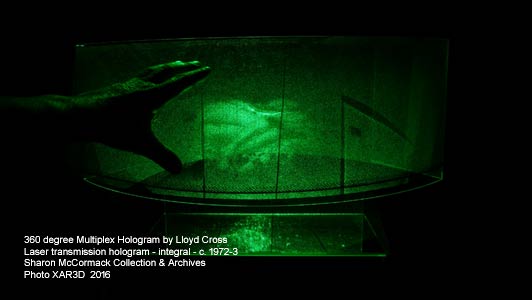
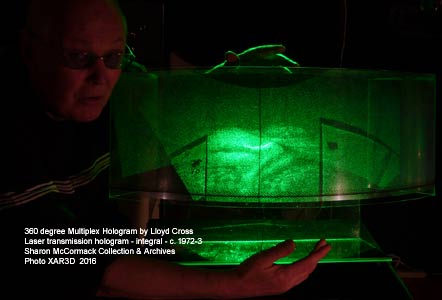
Sharon McCormack in the 1980's shooting multiplex subjects and personalities
Sharon McCormack authored film strip of Michael Jordan for 360 degree multiplex hologram printing
Holographic Stereogram or Integrals Printers & Design Technology
Multiplex Mark III Printer - Diagram - Photos Sharon McCormack Collection & Archives
Mark III Optical Printer for Holographic Stereograms at Multiplex Company - photo John Fairstein
See John Fairstein's histories of The San Francisco School of Holography (web site with pages)
Multiplex Mark IV Printer - Diagram - Photos Sharon McCormack Collection & Archives
Multiplex Mark V Printer - Diagram - Sharon McCormack Collection & Archives
Tunable Cylindrical Lens and Collimating Lens for Mark V Printer constructed by Sharon McCormack
Sharon McCormack photo with her tunable lenses in Collection & Archives
Helium-Neon Laser used by Sharon McCormack and Subject Turntable Apparatus - Collection & Archives
Sample hologram projection unit - display unit for McCormack holographic stereograms - 360 degree cylinder & walk-around view.

Photos of Lloyd Cross and Sharon McCormack - Multiplex and School of Holography
Lloyd Cross and Sharon McCormack worked together in the 1970's to develop the optical technology for the "Mark III" and later optical printers used in the production of Multiplex holographic stereogram movies. These movies increased in size and duration from 120 degree movies to 360 degrees, and contemplated for reel to reel displays as well. The 'tunable lenses' of the Multiplex printers allowed them to create Multiplex holographic stereograms (integrals) of unsurpassed quality. These lenses were widely shared and distributed. Photos from the Sharon McCormack Collection & Archives.
Early Multiplex and School of Holography Histories referenced here:
'The Story of Multiplex' & School of Holography by Lloyd Cross (.PDF)
John Fairstein's The San Francisco School of Holography (web site with pages)
Lloyd Cross - Bio / Achievements up to 1970 (.PDF)
Jerry Pethick - Bio / Achievements up to 1970 (.PDF)
Multiplex Company Catalog - Distribution Flyer late 1970's
Multiplex Company Catalog - Distribution Flyer late 1970's (.PDF downloadable file)
The Decline of Multiplex as observed by Stephen Benton in 1977
SAN FRANCISCO SCHOOL OF HOLOGRAPHY
Founded by Lloyd Cross and Jerry Pethick 1971
Dr. Lloyd Cross, a physicist previously engaged at Willow Run Labs in Michigan joined forces with Jerry Pethick, a Canadian artist educated in England also interested in holography, and went to San Francisco and created a School of Holography for artists and artisans, with home-made lab equipment available for people outside of labs. During this time in 1972-73 Lloyd Cross invented 'the Multiplex white-light transmission motion-picture hologram' and formed a company with film-makers and holographers he had trained, the MULTIPLEX COMPANY to produce, distribute, educate and disseminate white-light transmission motion-picture holographic stereograms across the world.
NOTA BENE: What's also interesting is that these two partners Cross and Pethick had worked to create the first 'holographic art exhibitions' to happen in North America in the late 1960's. This story is told HERE

Photo of Jerry Pethick (left) and Lloyd Cross (right) - circa 1970 - collection of Margaret Pethick.
The San Francisco School of Holography was the predecessor to 'Multiplex company' and multiplex activities. The multiplex (integral) printers were first developed there. Its philosophy of 'knowledge should be free' directly led to the creation of a vibrant culture of holographic artists, holographic entrepreneurs and production facilities on the west-coast and world-wide. This culture existed beyond the boundaries of any 'university'.
|
The first student at the San Francisco School of Holography was Lon Moore. Yes, he was registered as such by the school co-founder Jerry Pethick. "There were no sandboxes, lasers, holograms... nothing but a chair and a foldout cardtable... But doing his best job of putting on a business face, he found a piece of paper and handwrote School of Holography at the top, and underneath that he wrote: 1. Lon Moore" "He explained that very soon the room would have 4 sand tables with lasers that would be surrounded by black Poly walls. I was thrilled and gave him $50." -- Lon Moore recollections by e-mail, (2021) Another student John Fairstein also recalls the school: "The School of Holography was located in a cavernous warehouse on Shotwell Street in the Mission District. The enormous space was divided roughly down the middle -- the left half consisting of a workshop, darkrooms, and a small 'classroom' area in the back. The right side was used as a display area, meeting room, and living space for some of the SOH denizens (Sharon McCormack, Rufus Friedman, Michael Kan, Alan?, Gary Adams, Jerry Pethick, Lloyd Cross, Lon Moore, Fred Unterseher, Pam Brazier, Dave Schmidt, et al). Since darkrooms areas were interspersed throughout, the lighting was subdued and indirect, further enhancing the cavern atmosphere. " -- John Fairstein, 'School of Holography') |
It wasn't an accredited 'school', there were few departments anywhere who would accredit a 'school of holography' in those days. It wasn't run as a business, efficiently, and that meant it couldn't survive in a world of commerce and competition. Here was the idea of 'open education', the sharing of ideas, the passing of skills and a 'cooperative structure' which really was an experiment with what kind of business could be created for participants to benefit by. Similar ideas of co-ops were evident in experimental film groups in the 1960's and 70's. This was a 'seed' which brought forth other schools, other teachers, and a practice of creations and eduction what continues to this day around the globe.
Lloyd Cross - Bio / Achievements up to 1970 (.PDF)
Jerry Pethick - Bio / Achievements up to 1970 (.PDF)
SOH listing by Cross of 'Permanent Directors' and 'Founders Shares'
'to include some who just dropped by regularly', and as appointed by Lloyd Cross (courtesy Lon Moore):
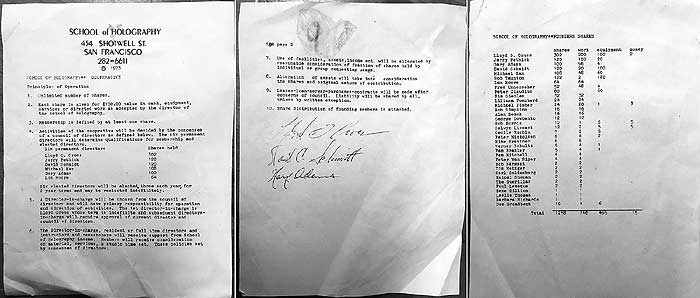
This first of its kind San Francisco School of Holography from 1971 would produce a number of future teachers, artists, and artisans creating and exhibiting in holography. And Multiplex holograms would catch on globally and feature more sophisticated methods of creating motion-pictures in rotating cylinders. This was the 70's - 80's of experimental artistic practices which informed later decades in the arts and displays of holography.
Invention and construction of Multiplex printers took place at the San Francisco School of Holography under direction of Lloyd Cross.
The Linda Lane 'Laser Lady Meets the Light Junkies' book contains diary notes on the building of a multiplex printer for the making of Dali Alice Cooper hologram

First Textbook of School of Holography by Jerry Pethick
Downloadable: (FULL TEXT) 'On Hologaphy and a Way to Make Holograms' by Jerry Pethick 1971 (.PDF)
The textbook for the SF School of Holography by Jerry Pethick contains mention of contributors including co-founder Lloyd Cross.
Graduates of SF School of Holography Start their Own Schools
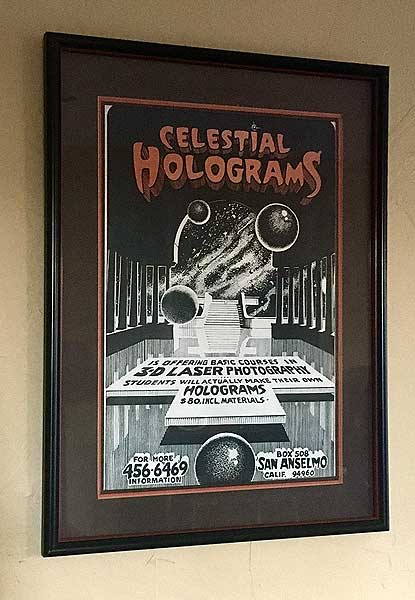
'Celestial Holograms' by Dave Sheridan for Lon Moore -- 1974 poster advertising his production and educational facilities
where a number of students, including Canadians were educated in holography.
For a more in-depth look at Lon Moore's early holograms see Early holograms by Lon Moore

|
John Fairstein recalls: "In 1973, one of my Antioch classmates, Lon Moore, returned to San Francisco after a brief stint in his family's textile business in Puerto Rico. Back in San Francisco, Moore spent his days with Lloyd Cross and the School of Holography, working odd jobs to support himself. Together we rented a house in the Sunset District. Moore convinced Fred Unterseher and me to work together to start an independent holography studio. I gave it the name 'Celestial Holograms'. Later Randy James, another classmate, Nancy Gorglione, and her friend Dave also joined. Constance Lubin was an active and enthusiastic supporter from the getgo. "Fred Unterseher, a skilled carpenter as well as a gifted artist, constructed a darkroom and also an apartment for Moore in the basement. Then we built an enormous 5X10 foot sandbox holography table. (I'll never forget my chagrin when the sand I ordered proved to be too dusty. Only washed silica sand works). "Michael Kan built us a 15mW laser for $400. He used a surplus tube mounted on a triangular optical rail with exposed mirrors. The power supply, running at 6 kV was also completely exposed. More than once people were shocked by brushing against it in the dark. In one jolting instance, the arc also blew out one of the filter capacitors which shut us down for several days. I built a set of optics mounts out of particle board and PVC pipe. Immediately after completing the set-up, we began making reflection holograms to sell."
|
Multiplex Company came out of the S.F. School of Holography

First person historical accounts of School of Holography & Multiplex Co.:
'The Story of Multiplex' & School of Holography by Lloyd Cross (.PDF)
John Fairstein's The San Francisco School of Holography (web site with pages)
-- Read more excerpts on the school & multiplex printer history by Fairstein - above
SF SCHOOL OF HOLOGRAPHY EXPANDS & FOUNDS L.A. SCHOOL OF HOLOGRAPHY 1974

See Los Angeles School of Holography Press Release and promises in separate window.
|
The venture did not go well, as Linda Lane explains Wednesday, July 17th, 1974 "The school of Holography had opened a branch in Santa Monica, and as usual they were struggling. Gary Adams an original member of Lloyd's San Francisco crew had relocated to set it up to teach. Ironically, people were vowed by 3-D images, but they didn't necessarily want to opay to learn how to make one. ( ........ ) "I could see that Gary Adams, although smiling, was looking especially gaunt. The Santa Monica school's phone was about to turned off, signalling a replay of San Francisco. I bought a small, old, classic hologram of a butterfly, poet sparkle plates, and a spaceman. He needed money and I desperately needed holograms to sell."
|
Sharon McCormack's Diploma - SF School of Holography
Sharon McCormack joined together with Lloyd Cross in the mid 1970's and later in the production and marketing of Multiplex technology, tunable lenses.
Return of the 'School of Holography' in the 1970's
In the later 1970's Sharon McCormack, Lloyd Cross and Michael Kan resumed teaching holography under the banner of 'School of Holography', now located just down the street at 550 Shotwell St., after the original school had ceased operations when the sand table rooms (for exposing holograms) were taken over by 'Multiplex Co.' Sample scans of SF School of Holography offered by McCormack, Cross, Kan in 1978 at her home location show the pamphlet / promotional material. Sharon McCormack Collection & Archives 2016.
School of Holography Project - 50 ft. rainbow for exhibition
SF SCHOOL OF HOLOGRAPHY INSTALLS MULTIPLEX IN CHICAGO 1977
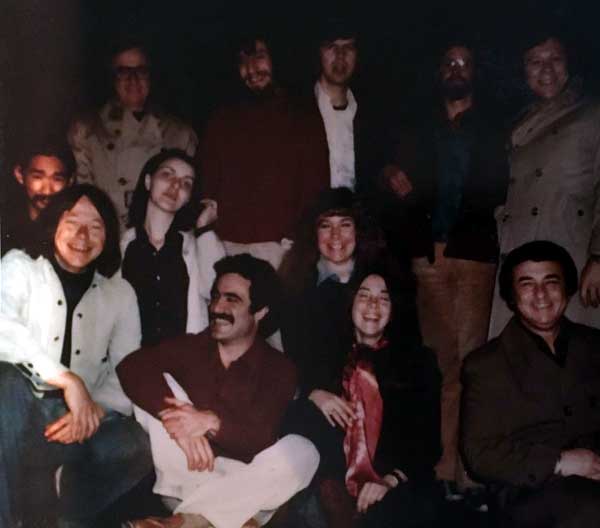
Lloyd Cross and SF School of Holography install multiplex technology in Chicago 1977
- group photograph along with Chicago people - courtesy of Lon Moore
Historical background on early SF School of Holography and Multiplex Company:
'The Story of Multiplex' & School of Holography by Lloyd Cross (.PDF)
Lloyd Cross - Bio / Achievements up to 1970 (.PDF)
Jerry Pethick - Bio / Achievements up to 1970 (.PDF)
'The San Francisco School of Holography' by John Fairstein
Embossed Commercial, commissioned and artistic works for mass media
Solo and Collaborative and Artistic works by Sharon McCormack
with portraiture in holographic stereograms in various formats: multiplex cylinder, framed in exhibition, foil embossed on advertising, sports covers & cards, original embossed printing shims - photos by Al Razutis 2016
MacCormack Embossed Commercial Works typically re-mastered with American Bank Note Holographics - Ken Haines
AUDIO CD COVER - DIAMONDS AND PEARLS - PRINCE
Unique collectibles - Historical milestones
Signed Embossed Holograms - Metal Shims - An Art in itself
These unique works combine integral holographics with embossing masters and steel shims used in mass producing these motion-picture images world wide. They are art works in themselves, historical and collectible as museum or collection pieces, and considered by some to be on par with '3D Daguerrotype on glass'. Included in this series are signed holograms by Sharon McCormack.
'The Jester' by Sharon McCormack - signed embossed holograms & hologram shim master in metal frame
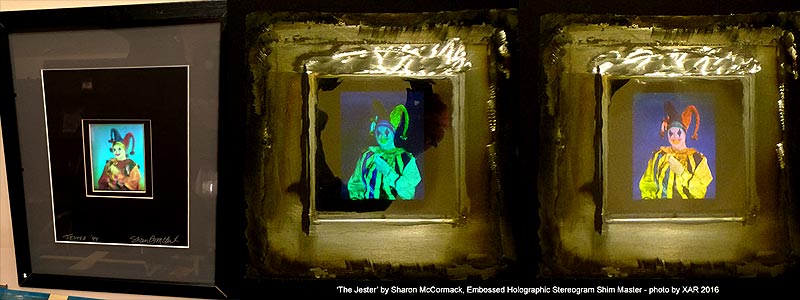
'Chief Delvis' by Sharon McCormack - signed embossed holograms and shim masters on metal


'Carl Ripkin' & 'Lombardi Trophy' by Sharon McCormack - Embossed Holographic Works
'Synthetic world' & 'Michael Jordan' by Sharon McCormack - Embossed Holographic Works

Collaborated on National Geographic Magazine Covers with Holograms
National Geographic 'Exploding Earth' Hologram cover project

"McCormack embossed commercial Works were typically done in conjunction with American BankNote Holographics under the supervision of Ken Haynes"
Embossed printed foils - 4 ft. wide roll in the archives

This Collection and Archive is for sale according to special terms and conditions, and available for lease or rental/exhibition individually or in groups of works.
It is on display, stored and preserved at Visual Alchemy Studio which is located in British Columbia, Canada.
To lease/exhibit or display selections from this Collection & Archives see Terms and Conditions
For all collectibles and holographic art purchases on this web site and domain, please contact Al Razutis at alrazutis@ymail.com to discuss your interests.
Sharon McCormack Art Bio Information
Previously Released Bios or News Stories
Photos of Life and Works
New releases of Sharon McCormack bio videos:


Sharon McCormack as Producer, Cinematographer, Holographer, VFX Supervisor
SPIE 1986 Paper by McCormack: "Special Effects Techniques for Integral Holograms"
Sharon McCormack as Actor
Multiplex Holograms in 1984 Los Angeles Exhibition 'The Peoples of Los Angeles'
These Works can be rented/leased individually or in curated groups
VIDEOS on YOU TUBE - 3D and 2D of Holograms @ Visual Alchemy

VIDEOS on FACEBOOK - 3D and 2D of Holograms @ Visual Alchemy

More subjects found on Sharon McCormack's work in stereo 3D: 'West-Coast Artists In Light' Vol. 4
Narrated Video of works on YouTube in Stereo (anaglyph) 3D
3D
Anaglyph 3D video of multiplex holographic stereograms by Sharon McCormack on YouTube
3 min. video by XAR3D 2004 --
YouTube 3D:

>> PLAYLIST for McCormack Archives on YOUTUBE>
To exhibit or lease works individually or in curated groups from McCormack Archives contact Al Razutis @ Visual Alchemy - e-mail alrazutis@ymail.com
Razutis Projects and Exhibitions Page
